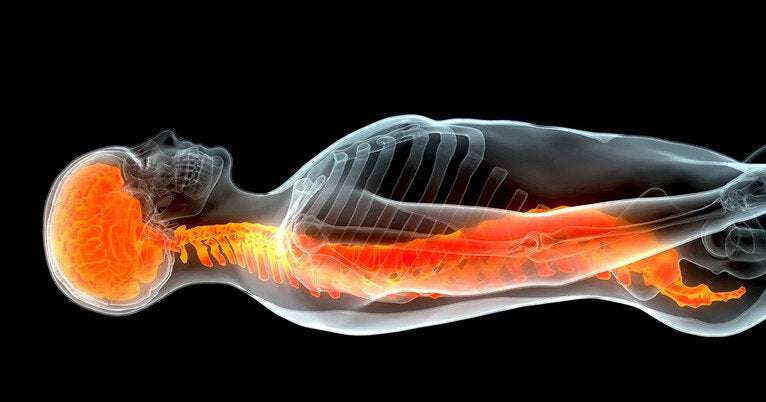Intravenous injection of bone marrow derived stem cells (MSCs) in patients with spinal cord injuries led to significant improvement in motor functions, researchers from Yale University and Japan report Feb. 18 in the Journal of Clinical Neurology and Neurosurgery.
For more than half of the patients, substantial improvements in key functions — such as ability to walk, or to use their hands — were observed within weeks of stem cell injection, the researchers report. No substantial side effects were reported.
The patients had sustained, non-penetrating spinal cord injuries, in many cases from falls or minor trauma, several weeks prior to implantation of the stem cells. Their symptoms involved loss of motor function and coordination, sensory loss, as well as bowel and bladder dysfunction. The stem cells were prepared from the patients’ own bone marrow, via a culture protocol that took a few weeks in a specialized cell processing center. The cells were injected intravenously in this series, with each patient serving as their own control. Results were not blinded and there were no placebo controls.
Yale scientists Jeffery D. Kocsis, professor of neurology and neuroscience, and Stephen G. Waxman, professor of neurology, neuroscience and pharmacology, were senior authors of the study, which was carried out with investigators at Sapporo Medical University in Japan. Key investigators of the Sapporo team, Osamu Honmou and Masanori Sasaki, both hold adjunct professor positions in neurology at Yale.
Kocsis and Waxman stress that additional studies will be needed to confirm the results of this preliminary, unblinded trial. They also stress that this could take years. Despite the challenges, they remain optimistic.
“Similar results with stem cells in patients with stroke increases our confidence that this approach may be clinically useful,” noted Kocsis. “This clinical study is the culmination of extensive preclinical laboratory work using MSCs between Yale and Sapporo colleagues over many years.”
“The idea that we may be able to restore function after injury to the brain and spinal cord using the patient’s own stem cells has intrigued us for years,” Waxman said. “Now we have a hint, in humans, that it may be possible.”

lastcrayon on February 23rd, 2021 at 14:40 UTC »
My wife had a head-on collision in 2004. This resulted in 2 upper spine fusions and a decade of pain that ripples through relationships, finances and self worth. Our relationship was hanging on by a thread. I thought I was going to come home to her hanging in the closet. She had given up and I had given up 'silently'.
Then...in 2017 I sought out Stem Cell. She went in at 9am, they pulled the cells from her hip, put them in her neck and we were home by Noon. On the way home she said, "this is the first time I haven't had a headache in 10 years." I almost wrecked the car.
Since then she has lost over 100lbs (due to getting off all the pain prescriptions), reconnected with family, travel, play sports, back to cooking, shopping on Amazon (sigh).
Our house is no longer a dark deserted place. She is full of life again.
All to Stem Cell
koosman on February 23rd, 2021 at 14:07 UTC »
Seems quite promising, but it's important to be aware that there are a few negatives to this report (as with most, I'm sure, and at least the researchers involved are quite honest about its shortcomings). People tend to have a knee-jerk emotional reaction to news like this, and this is exactly the kind of reporting that will cause hysterically angry parents to demand a week down the line that their paralyzed child receive an immediate stem cell infusion, when it's not considered the current standard of care anywhere in the world... I certainly wouldn't consider doing it at this stage -- any adverse event leaves you critically medicolegally exposed.
Firstly, these are all patients with cervical central cord syndrome, which does typically have a better prognosis for spontaneous recovery than most spinal cord injuries. Secondly, the patients they included are all relatively young (fewer than 10% of them over 60), whereas most patients who sustain spinal cord injuries from sudden hyperextension are in the older cohort, and older patients tend to show less recovery than younger ones (so the Scivoletto population study might not be an accurate comparison). Thirdly, this is not a controlled study, simply an observational one compared to previously published population outcomes.
The most important finding was the absence of adverse effects in this small study, and this definitely paves the way for a formal controlled study, and hopefully the eventual inclusion of MSC in spinal cord injury management protocols. From what I can see it seems relatively straightforward and probably quite affordable (bone marrow harvest, extract and culture stem cells, infuse intravenously), and certainly something that could be done with relative ease in most spinal centres. One ASIA grade makes a giant difference to functional capacity and the likelihood for independence.
schattmultz on February 23rd, 2021 at 11:47 UTC »
It really pains me to think about the kind of advancements we could’ve made by now if stem cell research was properly funded and allowed from the get go.